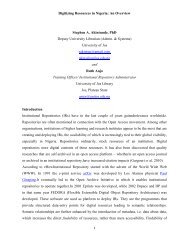Professor Atiene Solomon Sagay - University of Jos Institutional ...
Professor Atiene Solomon Sagay - University of Jos Institutional ...
Professor Atiene Solomon Sagay - University of Jos Institutional ...
Create successful ePaper yourself
Turn your PDF publications into a flip-book with our unique Google optimized e-Paper software.
4. Posters <strong>of</strong> high-risk obstetric factors requiring referral should be placed in strategic<br />
areas in the consulting rooms at PHCs to serve as reminders for the healthcare<br />
workers.<br />
5. Basic infrastructure in PHCs should be provided and maintained.<br />
6. Each local government area should consider appointing a supervising consultant<br />
obstetrician to maintain the standard <strong>of</strong> services in its PHCs.<br />
PHCs in <strong>Jos</strong> are better staffed in comparison to PHCs in more rural communities in the State<br />
(see Table 1). The poor antenatal services observed in PHCs around <strong>Jos</strong> are therefore likely to<br />
be a more generalized problem. Sub-standard care in this situation does not only put pregnant<br />
women‘s lives at risk but it represents a missed opportunity to impact positively on the poor<br />
maternal and perinatal health statistics in the area.<br />
4. Are there any concerns about survival <strong>of</strong> the newborn?<br />
The global burden <strong>of</strong> newborn illness shows that a disparity <strong>of</strong> up to 30-folds exists between<br />
countries with highest and lowest newborn death statistics. Four million babies die in<br />
developing countries annually and about 42% <strong>of</strong> these deaths are due to infections. Other<br />
major causes include perinatal asphyxia (21%), birth injuries (11%), prematurity and low<br />
birth weight (10%) and congenital abnormalities (11%). It was also observed that two-thirds<br />
<strong>of</strong> the deaths in the neonatal period occur in the first week; among these deaths, two-thirds<br />
occurred within the first 24 hours.<br />
skilled care at facility levels such as emergency obstetric care services are<br />
recommended for saving maternal and newborn lives (Bhutta et al 2008).<br />
scale-up <strong>of</strong> community and household care are necessary for improving<br />
newborn and child survival<br />
Programmes that are necessary for the reduction in neonatal morbidity and mortality rates are<br />
for countries to employ rational mix <strong>of</strong> quality clinical services, effective public health<br />
measures and inexpensive community-based interventions in public and private sectors and to<br />
scale-up known cost-effective interventions such as the mother-baby packages. (Sule and<br />
Onayade 2006). Strengthening Maternal Newborn and Child Health services at the primary<br />
health-care level should be a priority for countries to reach their Millennium Development<br />
Goal targets for reducing maternal and child mortality.<br />
5. Are there emerging challenges to motherhood in the HIV era?<br />
Trend <strong>of</strong> HIV prevalence in women in Plateau State<br />
Our study <strong>of</strong> the HIV epidemic in pregnant women in Nigeria started in 1999 when we<br />
reported the yearly trend <strong>of</strong> HIV sero-prevalence among pregnant women in <strong>Jos</strong> over a 10year<br />
period (1989 – 1998). A total <strong>of</strong> 11,059 pregnant women were screened and 134 (1.24%)<br />
were HIV positive. The yearly trend showed a rise in HIV sero-prevalence from 0.25% (1 in<br />
394) in 1989 to 3.69% (1 in 27) in 1997(<strong>Sagay</strong> et al 1999). The trend <strong>of</strong> yearly HIV<br />
prevalence among pregnant women from 1989 to 2001 is shown in Figure 1.<br />
12













